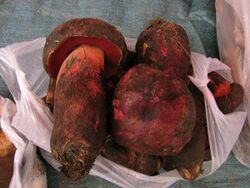Biology:Rubroboletus sinicus
| Rubroboletus sinicus | |
|---|---|

| |
| Scientific classification | |
| Domain: | Eukaryota |
| Kingdom: | Fungi |
| Division: | Basidiomycota |
| Class: | Agaricomycetes |
| Order: | Boletales |
| Family: | Boletaceae |
| Genus: | Rubroboletus |
| Species: | R. sinicus
|
| Binomial name | |
| Rubroboletus sinicus (W.F.Chiu) Kuan Zhao & Zhu L.Yang (2014)
| |
| Synonyms[1] | |
| |
Rubroboletus sinicus is a bolete fungus in the family Boletaceae. It is found in China. The species was first described by Wei Fan Chiu as Boletus sinicus in 1948,[2] and transferred to the genus Tylopilus in 1979 by Fanglan Tai.[3] In 2014, the genus Rubroboletus was created to accommodate this and allied species.[4]
The fruit bodies of R. sinicus` have a brown, pulvinate (cushion-shaped) cap measuring 9–11 cm (3.5–4.3 in) in diameter that is covered with fibrous scales. The tubes on the cap underside are up to 4 mm (0.16 in) long, and stain blue when cut or injured. The pores are red and small, up to 0.5 mm across. The flesh is initially white to yellowish, but stains blue with injury. Spores are ellipsoid and measure 7.5–11 by 4.5–5.5 µm. The type collection was obtained from a market in Kunming in July, 1938.[2]
References
- ↑ "GSD Species Synonymy: Rubroboletus sinicus (W.F. Chiu) Kuan Zhao & Zhu L. Yang". Species Fungorum. CAB International. http://www.speciesfungorum.org/GSD/GSDspecies.asp?RecordID=809236. Retrieved 2015-06-20.
- ↑ 2.0 2.1 Chiu WF. (1948). "The boletes of Yunnan". Mycologia 40 (2): 199–231 (see p. 220). doi:10.2307/3755085. http://www.cybertruffle.org.uk/cyberliber/59350/0040/002/0220.htm.
- ↑ Tai FL. (1979). Sylloge Fungorum Sinicorum. Peking: Science Press, Academica Sinica. p. 758.
- ↑ "A new genus, Rubroboletus, to accommodate Boletus sinicus and its allies". Phytotaxa 188 (2): 61–77. doi:10.11646/phytotaxa.188.2.1.
External links
Wikidata ☰ {{{from}}} entry
 |

